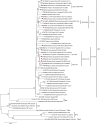Integrated analysis of human-animal-vector surveillance: West Nile virus infections in Austria, 2015-2016
- PMID: 29535293
- PMCID: PMC5849732
- DOI: 10.1038/s41426-018-0021-5
Integrated analysis of human-animal-vector surveillance: West Nile virus infections in Austria, 2015-2016
Abstract
The results of integrated human and veterinary surveillance for West Nile virus (WNV) infections in Austria during the transmission seasons 2015 and 2016 are shown. Altogether WNV nucleic acid was detected in 21 humans, horses, wild birds and mosquito pools. In detail: in four human clinical cases [two cases of West Nile fever (WNF) and two cases of West Nile neuroinvasive disease (WNND)]; eight blood donors [among 145,541 tested donations], of which three remained asymptomatic and five subsequently developed mild WNF; two horses with WNND, of which one recovered and one had to be euthanized; two wild birds [one goshawk and one falcon, both succumbed to WNND]; and five Culex pipiens mosquito pools. Compared to previous years the number of infections increased remarkably. All infections were recorded in the city of Vienna and neighboring regions of Lower Austria. Sixteen coding-complete WNV sequences were established which were closely related to each other and to other Austrian, Czech and Italian viruses, all belonging to the Central/Southern European cluster of WNV sublineage 2d. However, several genetically slightly different WNV strains seem to co-circulate in the same area, as demonstrated by phylogenetic analysis. Based on detailed sequence analysis, all newly discovered Austrian WNV strains had the potential to cause neurological disease, but no correlation was found between severity of disease and the analyzed genetic virulence/neuroinvasiveness markers. Results of integrated human-animal-vector surveillance presented in this paper provide a comprehensive description of WNV activity in the region and will facilitate proactive public health measures to prevent or mitigate potential outbreaks.
Conflict of interest statement
The authors declare that they have no conflict of interest.
Figures


Similar articles
-
West Nile and Usutu viruses co-circulation in central Italy: outcomes of the 2018 integrated surveillance.Parasit Vectors. 2021 May 7;14(1):243. doi: 10.1186/s13071-021-04736-z. Parasit Vectors. 2021. PMID: 33962673 Free PMC article.
-
A four-year survey (2011-2014) of West Nile virus infection in humans, mosquitoes and birds, including the 2012 meningoencephalitis outbreak in Tunisia.Emerg Microbes Infect. 2018 Mar 14;7(1):28. doi: 10.1038/s41426-018-0028-y. Emerg Microbes Infect. 2018. PMID: 29535295 Free PMC article.
-
West Nile virus infections in Greece: an update.Expert Rev Anti Infect Ther. 2012 Jul;10(7):743-50. doi: 10.1586/eri.12.59. Expert Rev Anti Infect Ther. 2012. PMID: 22943398 Review.
-
Explosive spread of a neuroinvasive lineage 2 West Nile virus in Central Europe, 2008/2009.Vet Microbiol. 2013 Jul 26;165(1-2):61-70. doi: 10.1016/j.vetmic.2013.03.005. Epub 2013 Mar 15. Vet Microbiol. 2013. PMID: 23570864
-
The Spread of the Mosquito-Transmitted West Nile Virus in North America and Europe.Microb Biotechnol. 2025 Mar;18(3):e70120. doi: 10.1111/1751-7915.70120. Microb Biotechnol. 2025. PMID: 40035176 Free PMC article. Review.
Cited by
-
Polymerase Spiral Reaction Assay for Rapid and Real Time Detection of West Nile Virus From Clinical Samples.Front Cell Infect Microbiol. 2020 Aug 27;10:426. doi: 10.3389/fcimb.2020.00426. eCollection 2020. Front Cell Infect Microbiol. 2020. PMID: 32984063 Free PMC article.
-
West Nile Virus in Slovenia.Viruses. 2020 Jul 3;12(7):720. doi: 10.3390/v12070720. Viruses. 2020. PMID: 32635155 Free PMC article.
-
Fitness adaptations of Japanese encephalitis virus in pigs following vector-free serial passaging.PLoS Pathog. 2024 Aug 26;20(8):e1012059. doi: 10.1371/journal.ppat.1012059. eCollection 2024 Aug. PLoS Pathog. 2024. PMID: 39186783 Free PMC article.
-
An advanced sequence clustering and designation workflow reveals the enzootic maintenance of a dominant West Nile virus subclade in Germany.Virus Evol. 2023 Mar 17;9(1):vead013. doi: 10.1093/ve/vead013. eCollection 2023. Virus Evol. 2023. PMID: 37197362 Free PMC article.
-
Emergence of West Nile virus lineage 2 in Europe: Characteristics of the first seven cases of West Nile neuroinvasive disease in horses in Austria.Transbound Emerg Dis. 2020 May;67(3):1189-1197. doi: 10.1111/tbed.13452. Epub 2019 Dec 24. Transbound Emerg Dis. 2020. PMID: 31840920 Free PMC article.
References
-
- Petrović T, Blazquez AB, Lupulović D, et al. Monitoring West Nile virus (WNV) infection in wild birds in Serbia during 2012: first isolation and characterisation of WNV strains from Serbia. Eur. Surveill. 2013;18:20622. - PubMed
MeSH terms
LinkOut - more resources
Full Text Sources
Other Literature Sources
Medical
Molecular Biology Databases
